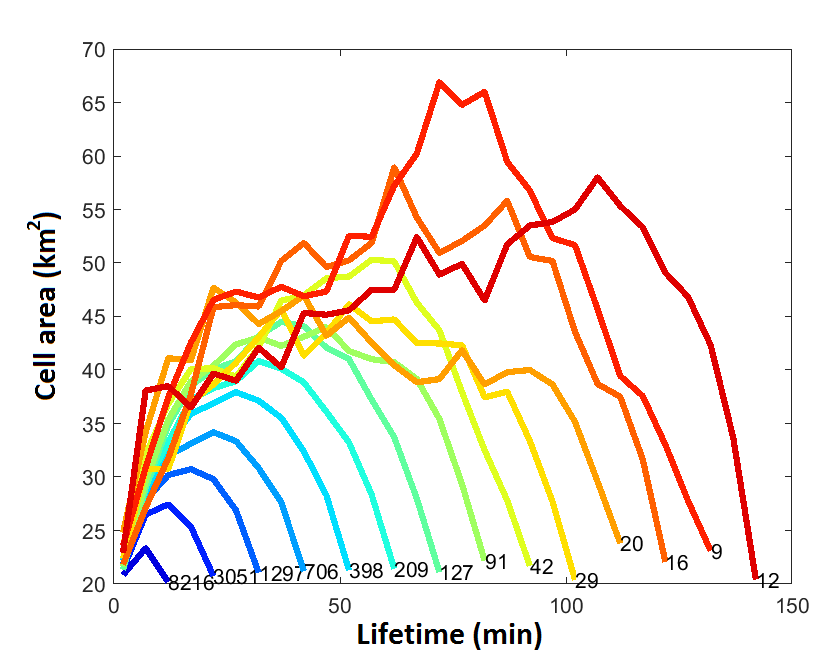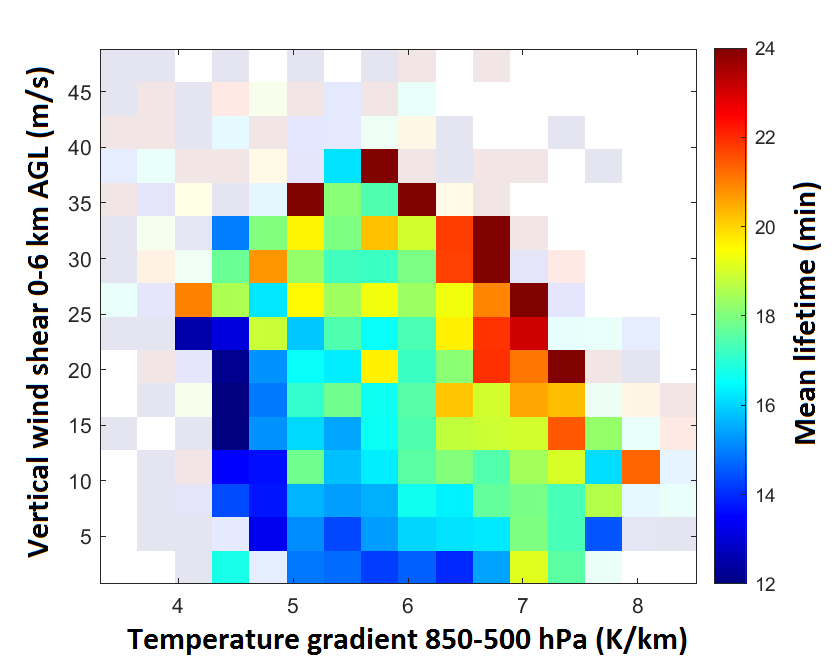How to understand better atmosphere’s influence on thunderstorm lifetime?
The seamless availability of satellite and weather radar data has made it possible to use cell tracking algorithms, especially in the last two decades. These algorithms can detect thunderstorm cells, among other things, and track their paths over long distances. From the point of view of warning and weather services and, for example, organizers of major events or air traffic, it is particularly interesting to know, where thunderstorms that have already formed will go in the next few minutes and hours and whether their intensity (and the associated perils) could increase or decrease. The development of intensity, in particular, currently requires even more intensive research, as many processes are not sufficiently understood yet.
In the project LifeCycle, a current research project of the working group "Atmospheric Risks" in cooperation with the German Weather Service (DWD), the influence of atmospheric environmental conditions on the life cycle of thunderstorms, i.e. the lifetime as well as the temporal evolution of cell size and intensity, is investigated. For this purpose, tracking data (based on radar data) of recent years are combined with model data of the DWD and statistically analyzed.
Figure 1 shows the temporal development of a thunderstorm characteristic – the area of the thunderstorm cell that exceeds a fixed radar reflectivity threshold (> 46 dBz) in weather radar data. The main focus was on thunderstorm cells that do not form larger convective complexes. It can be seen that short-lived thunderstorm cells are on average smaller than long-lived thunderstorm cells. In addition, it becomes clear that the temporal evolution of the cell area statistically corresponds on average to a downward-opening parabola, no matter how long the thunderstorm cells live. This new knowledge enables the development of a first, simplified life cycle model for the nowcasting (prediction of the next 2 hours) of thunderstorm cells.
Although on average the temporal development of the cell area can be approximated quite well by a curve, the variability of individual thunderstorm cells is nevertheless very high. Therefore, different atmospheric environmental conditions prevailing during the observation period of the thunderstorms are currently being investigated statistically in order to identify particular dependencies. These include meteorological parameters that describe the moisture content of the air (e.g., dew point), stability (e.g., lapse rate = vertical temperature gradient between two specific height levels) and the dynamics of the atmosphere (e.g., deep layer shear = wind difference between 0 and 6 km above ground). First analyses indicate that a trend towards longer lifetimes of thunderstorms can be observed the more unstable the stratification of the atmosphere (high values for the lapse rate between the 850 and 500 hPa pressure levels) and the higher the vertical wind shear (Fig. 2). Thunderstorm cells that occur at high deep layer shear and high lapse rates therefore live about twice as long as those that occur at low values. These results confirm the theory that the two investigated environmental variables show a positive effect on the organizational structure, i.e. the lifetime and size of thunderstorms, among other things.
This example represents just the beginning of further intensive investigations of the influence of atmospheric environmental variables on the life cycle of thunderstorms. In addition, innovative approaches will be tested, such as the use of recurrent neural networks to develop a machine-trained prediction model. With this project, the researchers from IMK-TRO and DWD are directly involved in the interface between current weather observation and very short-term forecasts. The overall goal is a seamless weather forecast for the next 12 hours.
|
Fig. 1: Mean evolution of the area of all thunderstorm cells (2011-2016, summer half-years), based on radar data, classified by their lifetime. Different line colors indicate different lifetimes. The numbers at the end of the lines correspond to the counts of incorporated cells (©KIT/Jannik Wilhelm). |
Fig. 2: Mean lifetimes of all thunderstorm cells (2011-2016, summer half-years), classified by two exemplary atmospheric environment parameters. Classes with less than 20 counts of thunderstorms are displayed transparently (©KIT/Jannik Wilhelm). |
Related links:
[Working group: Atmospheric risks]
Author: Jannik Wilhelm
2019/10/24


